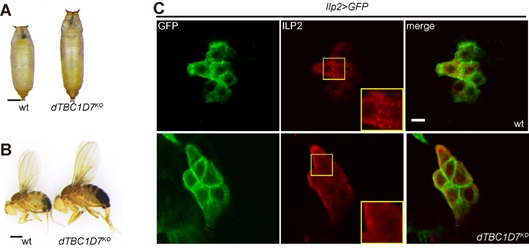The tuberous sclerosis complex (TSC) is an essential node of the insulin/IGF signaling transduction pathway and negatively regulates cell growth through inactivation of the mechanistic target of rapamycin complex 1 (mTORC1). The TSC complex includes TSC1, TSC2 and TBC1D7, a new member recently identified
. Somatic loss of heterozygosity in TSC1 or TSC2 leads to the occurrence of
benign tumors in various organs while the loss of TBC1D7 is associated with megalencephaly. These divergent phenotypes imply that TBC1D7 has some important physiological functions that are distinct from its conventional TSC-complex-associated functions.
With the goal of dissecting the physiological roles of TBC1D7, a group led by JIANG Yuqiang from the Institute of Genetics and Developmental Biology (IGDB), Chinese Academy of Sciences, in cooperation with a group led by WANG Tao from National institute of Biological Science (NIBS), identified a homology of TBC1D7 in Drosophila, named dTBC1D7 and established a genetic model.
By using
Drosophila genetics and imaging technologies, the scientists have characterized some native physiological functions of dTBC1D7 in Drosophila.
In mutants lacking dTBC1D7, cells and organs growth are promoted in a cell-noautonomous and TSC-independent manner. dTBC1D7 is expressed in insulin-like peptides producing (IPC) cells in center neuron system of fly and control the biosynthesis and
secretion of insulin-like peptides 2 (ILP2). Moreover, dTBC1d7 mutants were short-lived and accelerated aging processes due to elevation of circulating insulins.
This work offers novel insights of the physiological functions of TBC1D7 in systemic control of growth as well as significant implications of human disease caused by TBC1D7 mutation.
This project was supported by National of Science Foundation of China, the Ministry of Science and Technology and Chinese Academy of Sciences.
Figure 1. dTBC1D7 mutants increased body size in pupae (A) and adult stage (B). Flies were dissected and immunostained for GFP (IPC cells) and ILP2 (red). High magnification pictures are shown in yellow frames. In dTBC1D7 mutants, ILP2 is a secretion-like pattern (C). (Image by IGDB)
Contact:
Dr. JIANG Yuqiang
Email: yqjiang@genetics.ac.cn
 Figure 1. dTBC1D7 mutants increased body size in pupae (A) and adult stage (B). Flies were dissected and immunostained for GFP (IPC cells) and ILP2 (red). High magnification pictures are shown in yellow frames. In dTBC1D7 mutants, ILP2 is a secretion-like pattern (C). (Image by IGDB)Contact:Dr. JIANG YuqiangEmail: yqjiang@genetics.ac.cn
Figure 1. dTBC1D7 mutants increased body size in pupae (A) and adult stage (B). Flies were dissected and immunostained for GFP (IPC cells) and ILP2 (red). High magnification pictures are shown in yellow frames. In dTBC1D7 mutants, ILP2 is a secretion-like pattern (C). (Image by IGDB)Contact:Dr. JIANG YuqiangEmail: yqjiang@genetics.ac.cn CAS
CAS
 中文
中文




.png)
